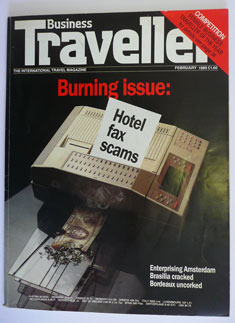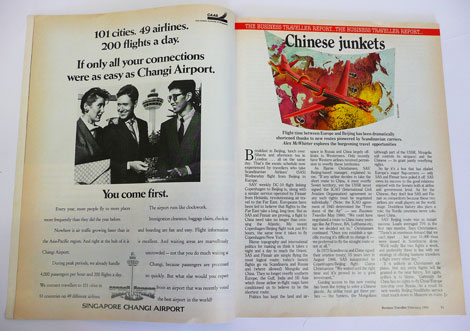Alex McWhirter looks through the Business Traveller archive. This month: a February 1989 article on flying to China
 Nowadays we take it for granted that a flight from Europe to China takes roughly the same time as it does to cross the Atlantic. But this wasn’t the case 25 years ago.
Nowadays we take it for granted that a flight from Europe to China takes roughly the same time as it does to cross the Atlantic. But this wasn’t the case 25 years ago.
In our February 1989 report “Chinese junkets”, we revealed how the opening up of new aviation corridors over the then USSR, Mongolia and mainland China changed the face of flying East forever.
Until 1988, Western airlines were forbidden to take the shortest route between Europe and China. Instead, they had to take the long way round via South East Asia, which meant the journey time was more than doubled. Not only was the routing longer but the planes of that era also had to make additional refuelling stops.
Worse still, during the height of the Vietnam War in the 1970s, that country’s airspace was also out of bounds, making the overall journey even longer. In the mid-1970s when I worked in the Cable and Wireless travel office in London, it could take executives as long to reach Hong Kong as it did Australia.
So the 1988 multi-stop time of around 16 hours to Beijing tumbled overnight to less than eight or nine hours nonstop depending on whether you departed from Helsinki or Copenhagen.
Finnair was the first carrier to secure the coveted rights to the shorter routing, followed soon after by Scandinavia’s SAS.
How did these two small fries steal a march on the big boys, namely Air France, British Airways and Lufthansa? It’s all down to history and the then political situation. The Nordic countries remained neutral during the Cold War and neither did they colonise China.
Faster flights brought China closer to Europe but the shorter times aloft weren’t matched by the passenger experience on the ground. We reported on how passengers using Beijing airport faced time-consuming procedures.
The capital’s airport lagged behind its Western counterparts in 1988. Ground handling was rudimentary and not computerised. It was carried out by Air China (which back then was a far cry from today’s Air China) and passengers had to report for check-in at least two hours ahead – excessive by the standards of that time.

SAS’s then Beijing manager, Bjarne Christiansen, explained that his airline supervised matters as much as it could “but we can’t change the situation here – it’s up to the authorities”.
SAS made the process easier for premium passengers by issuing boarding passes and baggage tags at its downtown office a day in advance. But once checked in, there was no SAS lounge in which to relax. “No airline can get its own lounge – there’s no space,” Christiansen said.
Catering was also put under the microscope. “At the catering centre an SAS member supervises matters from the actual preparation of food the day before to the delivery of meals to the plane at departure time.” All in all, a far cry from today.








